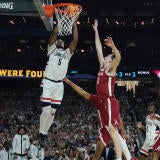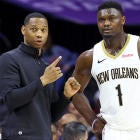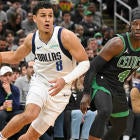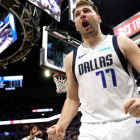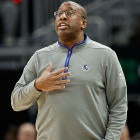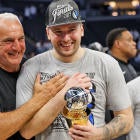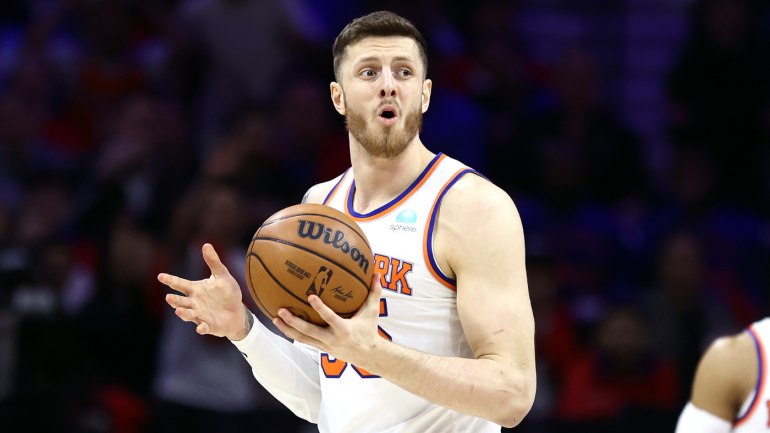
Isaiah Hartenstein became a New York Knick in part due to a quirk in the collective bargaining agreement. Let's wind the clock back three years. Hartenstein, then a journeyman having spent stints with the Rockets, Nuggets and Cavaliers, couldn't find a contract with another NBA team until weeks before 2021 training camp began. Eventually, he ultimately signed with the Los Angeles Clippers.
His lone season in Hollywood was a breakout success. Though his individual numbers didn't jump off of the page, Hartenstein developed into one of the NBA's most effective low-minutes rim-protectors backing up Ivica Zubac. In a perfect world, the Clippers would have re-signed him and kept him in that role indefinitely.
The problem was that he had so little value around the league before he signed in Los Angeles that he could only get a one-year deal from the Clippers when he joined them. That meant that, as a 2022 free agent, his original team only had Non-Bird Rights on him, allowing only a 20% raise on his minimum salary. He obviously wasn't going to take that. Their only other means of paying him something resembling fair value would have been their taxpayer mid-level exception. They instead spent it on John Wall, opening the door for the Knicks to give him their own mid-level exception.
Now, history is repeating itself. Hartenstein has been a revelation for the Knicks. That incredible rim-protection has carried over to New York but has sustained in a larger role. His rebounding, especially on offense, has become an essential part of the Knicks' identity. Throw in his floaters, screening and passing and he's become a significant offensive positive in addition to that great defense. The Knicks, like the Clippers before them, snagged a major free-agent bargain in Hartenstein.
And the Knicks, like the Clippers before them, are facing a major uphill battle in actually keeping him. The reason for that again traces back to his value around the league at the time of his last foray into free agency. If Hartenstein had the leverage to command a three-year deal in 2022, the Knicks would have been able to re-sign him in 2025 for any price up to the max. Three years after signing a contract with a new team, that team gains full Bird Rights on that player, which removes any restriction in what that team can pay that player other than his max salary even if they are over the cap.
But the Knicks only signed Hartenstein for two years. That means that instead of full Bird Rights, the Knicks only have Early Bird Rights, and with those rights, the Knicks can only offer Hartenstein a deal that starts at 175% of his previous salary or less. Essentially, that means that the Knicks can't pay Hartenstein more than roughly $16.2 million next season.
Is that going to be enough to keep him? It's hard to say. At 26, Hartenstein is still young and ascending. He's also never been a wire-to-wire NBA starter, and non-shooting centers often struggle to earn fair contracts on the open market. There are only 15 centers in the NBA making more this season than that maximum figure the Knicks can give Hartenstein. The bad news, frankly, is that Hartenstein is better than several of them. Zach Collins, Jusuf Nurkic and Nikola Vucevic were all overpaid this season, but they are a barometer Hartenstein will no doubt use in negotiating his next contract. If they're worth that much, why isn't he?
Of course, market conditions matter as much as player quality in free-agent negotiations. Collins, Nurkic and Vucevic all got paid with full Bird Rights, but for Hartenstein to match their salary, he'd need to get paid by a cap-space team. Is there such a team out there? Potentially, but it's no certainty. Eight teams are positioned to create significant cap space this summer if they want to: the Pistons, 76ers, Jazz, Thunder, Magic, Spurs, Hornets and Raptors. Let's immediately cross off the 76ers. They have Joel Embiid, they aren't going to pay a center. The Pistons (Jalen Duren), Jazz (Walker Kessler), Hornets (Mark Williams) and Magic (Wendell Carter Jr.) all have viable young centers already, so while they might want depth, they'll likely use their resources elsewhere. The Raptors are already paying Jakob Poeltl, so they're a reasonable cross-off as well.
That leaves two teams. New York's Bird Rights dilemma lines up perfectly for the Thunder to try to swipe Hartenstein. Oklahoma City can create roughly $35 million in cap space, but because of their impending extensions for Chet Holmgren and Jalen Williams, the Thunder probably don't want to hand out a long-term deal. That creates a logical deal structure here: The Thunder could offer Hartenstein a two-year deal with an inflated short-term salary that the Knicks couldn't match, but would allow Hartenstein to reenter free agency in 2026, when he is still only 28. Even if the Knicks give Hartenstein the biggest four-year deal they can, the gap in guaranteed money wouldn't necessarily be enormous, and it would force Hartenstein to wait until he was 29 or 30 to reenter free agency.
The question here is interest. Hartenstein is theoretically a perfect fit for the Thunder. He's comfortable being a backup, but he can play major minutes when needed. His physicality pairs perfectly with all of their shooting and ball-handling. He could play alongside Holmgren or without him. The issue here is that the Thunder, thus far, have shown little inclination to invest in a non-shooting center. They even helped the Mavericks get one in Daniel Gafford at the deadline. The Thunder want to play five-out offense as much as possible. Hartenstein can't do that. If that's a deal-breaker, the Thunder are out.
The Spurs are less dogmatic about shooting, and unlike the Thunder, they've shown more of a willingness to play their rookie star big man at power forward. Victor Wembanyama's best basketball came at center down the stretch, but he opened the season as a power forward and has in the past expressed his preference for the position. The Spurs are already paying Collins, but Hartenstein is both an upgrade and a stylistic divergence. The Spurs could potentially sign him, try both him and Collins next to Wembanyama and see which of them is a better fit.
But the Spurs have bigger needs here. If they're investing cap space in immediate help, point guard is the obvious target, but wing shooting would be welcome as well. Wembanyama was one of the best centers in the NBA after the All-Star break. Gregg Popovich has typically preferred to play big over the years, but paying two centers eight-figure salaries on top of Wembanyama would be a bit much even for him.
Let's say there isn't a big-money deal out there for Hartenstein. The Knicks will almost certainly offer him whatever deal he wants that is legally allowable. The next question then becomes what sort of structure he wants. The Knicks could pay Hartenstein up to around $72.5 million over four years, but if he's prepared to gamble a bit, he could also take a shorter-term deal with an eye on re-signing for fair value soon. The path to doing so would be a two-year deal worth a bit less than $34 million that contains a player-option on the second year. That would allow Hartenstein to opt-out and re-sign with full Bird Rights next summer or, if his value dips for any reason, at least take home a reasonable amount of guaranteed money.
Which option would he prefer? It's hard to say. Hartenstein is only now finishing his first non-minimum NBA contract. He hasn't earned generational wealth yet, and players under those circumstances tend to opt for security. But the Knicks saw firsthand this postseason just how essential Hartenstein is to who they are on both ends of the floor. They can't trust Mitchell Robinson to stay healthy and Tom Thibodeau teams rely on centers more than most. Hartenstein deserves more than $72 million. He surely sees that. The Knicks do, too. But giving it to him is going to be an uphill battle.











